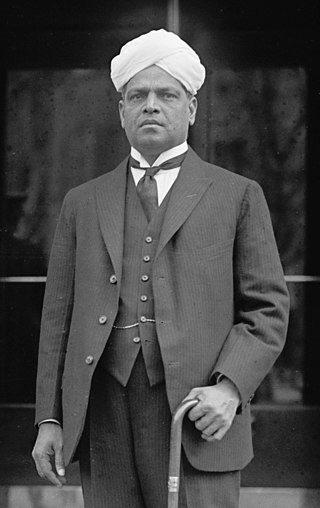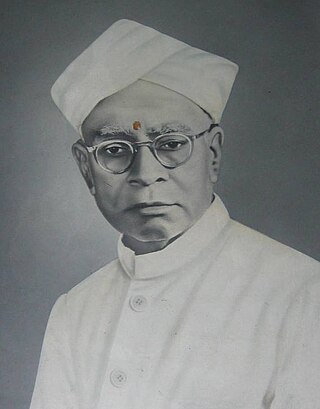Related Research Articles

Muthuswami Dikshitar (Mudduswamy Dikshitar) (IAST: muttusvāmi dīkṣitar, 24 March 1776 – 21 October 1835), mononymously Dikshitar, was a South Indian poet, singer and veena player, and a composer of Indian classical music, who is considered one of the musical trinity of Carnatic music. Muthuswami Dikshitar was born on 24 March 1776 in Tiruvarur near Thanjavur, in what is now the state of Tamil Nadu in India, to a family that is traditionally traced back to Virinichipuram in the northern boundaries of the state.

Syama Sastri or Shyama Shastri was a musician and composer of Carnatic music. He was the oldest among the Trinity of Carnatic music, Tyagaraja and Muthuswami Dikshitar being the other two.
Appayya Dixit, 1520–1593 CE, was a performer of yajñas as well as an expositor and practitioner of the Advaita Vedanta school of Hindu philosophy but with a focus on Shiva or Shiva Advaita.

Valangaiman Sankaranarayana Srinivasa Sastri was an Indian politician, administrator, educator, orator and Indian independence activist. He was acclaimed for his oratory and command over the English language. Srinivasa Sastri was born to a poor temple priest in the village of Valangaiman near Kumbakonam, India. He completed his education at Kumbakonam and worked as a school teacher and later, headmaster in Triplicane, Madras. He entered politics in 1905 when he joined the Servants of India Society. Sastri served as a member of the Indian National Congress from 1908 to 1922, but later resigned in protest against the non-cooperation movement. Sastri was one of the founding members of the Indian Liberal Party. In his later days, he was strongly opposed to the partition of India.

Krishnaswamy Subrahmanyam was an Indian international strategic affairs analyst, journalist and former civil servant. Considered a proponent of Realpolitik, Subrahmanyam was an influential voice in Indian security affairs for a long time. He was most often referred to as the doyen of India's strategic affairs community, and as the premier ideological champion of India's nuclear deterrent. His son S Jaishankar was appointed India's External Affairs Minister in 2019.
Vadama, meaning "Northerners", are a sub-sect of the Iyer community of Tamil Brahmins. While some believe that their name is an indication of the fact that they were the most recent Brahmin migrants to the Tamil country others interpret the usage of the term "Vadama" as a reference to their strict adherence to the Sanskrit language and Vedic rituals which are of northerly origin.

Tirumala Deva Raya was the first crowned Emperor of Vijayanagara from the Aravidu Dynasty. He was the younger brother of Rama Raya and the husband of princess Vengalamba, making him the son-in-law of Emperor Krishna Deva Raya. Following the Battle of Talikota, he rescued the last Tuluva Emperor, Sadasiva Raya, and relocated the imperial capital to Penukonda. After Sadasiva's death in 1570 CE, he ascended as the Emperor of Vijayanagara. He was succeeded by his son, Sriranga I in 1572.

Mandakolathur Patanjali Sastri was the second Chief Justice of India, serving in the post from 7 November 1951 to 3 January 1954.

Rai Bahadur SirPanapakkam AnandacharluCIE was an Indian lawyer and freedom fighter who was a founding delegate and later president of the Indian National Congress, founder and president of the Triplicane Literary Society, and founder of the Madras Mahajana Sabha. He additionally aided the Triplicane Six in founding The Hindu, to which he was a frequent contributor.

Kallidaikurichi Aiyah Nilakanta Sastri was an Indian historian who wrote on South Indian history. Many of his books form the standard reference works on the subject. Sastri was acclaimed for his scholarship and mastery of sources and was a recipient of the third highest Indian civilian honour, the Padma Bhushan.

Vishnampet R. Ramachandra Dikshitar was a historian, Indologist and Dravidologist from the Indian state of Tamil Nadu. He was professor of history and archaeology at the University of Madras and is the author of standard text books on Indian history.
Diwan Bahadur Sakkottai Krishnaswamy Aiyangar was an Indian historian, academician and Dravidologist. He chaired the Department of Indian History and Archaeology at the University of Madras from 1914 to 1929.

Thiruvalangadu Raju Venkatarama SastriCIE was an Indian lawyer and politician who served as the Advocate-General for Madras Presidency from 1924 to 1928. He was also known as T.R.V.Sastri.
Venkataraman Raghavan (1908–1979) was a Sanskrit scholar and musicologist. He was the recipient of numerous awards, including the Padma Bhushan and the Sahitya Akademi Award for Sanskrit, and authored over 120 books and 1200 articles.

The Nayakas of Kalahasti were a line of rulers of Kalahasti and Vandavasi principalities. Members of the group include Damarla Chennapa Nayaka, after whom the city of Chennai is named. The Kalahasti Nayaks had their origins in the Velama warrior clans of present-day Andhra Pradesh. These Nayakas served as vassals of the late Vijayanagara Empire, then held by the Aravidu Dynasty and headquartered at Chandragiri and Vellore.
Rai Bahadur Valaiyattur Venkayya was an Indian epigraphist and historian. He served as the Chief Epigraphist to the Government of India from 1908 to 1912.

Chetput Ramaswami Iyer Pattabhiraman was an Indian lawyer and politician from the Indian National Congress. He was the eldest son of Indian statesman C. P. Ramaswami Iyer. He served as a Member of Indian Parliament from Kumbakonam from 1957 to 1967 and as a Union Minister from 1966 to 1967.
Calamur MahadevanFNAFGMMSI, sometimes known as C. Mahadevan, was an Indian specialist in economic geology, marine geology, and nuclear geology, and 1934 Founding Fellow of the Indian Academy of Sciences, elected for Earth and Planetary Sciences, serving on the Council of the Indian Academy of Sciences from 1948 until his 1962 death. Chosen as a Fulbright scholar, with aid from the United States National Research Council, he taught at the Massachusetts Institute of Technology. Appointed to the first Professorship of Geology at Andhra University after fourteen years as Superintendent Geologist at the Geological Survey of Hyderabad, he was known as a doyen or foundational figure in the field of Indian geology.
Calamur Chandrasekhara Sastri (1854–1887), sometimes Sastry or Sastriyar, was the first Principal and Professor of English and Sanskrit of the Maharajah's College at Vizianagaram from his appointment in 1875, developing it from a secondary school with four teachers into a graduate institution before his death at the age of 32 in 1887, with the support of the contemporaneously reigning Maharajas of Vizianagaram, Pusapati Vijayarama Gajapathi Raju III and Pusapati Ananda Gajapati Raju. He was the first Indian principal of any South Indian college at the time.
References
- ↑ Subrahmanyam, N. The Geographical Personality of India.
- ↑ "The Indian Geographical Society (IGS)". igschennai.org. Retrieved 2024-03-19.
- ↑ "The Indian Geographical Society (IGS)". igschennai.org. Retrieved 2024-03-19.